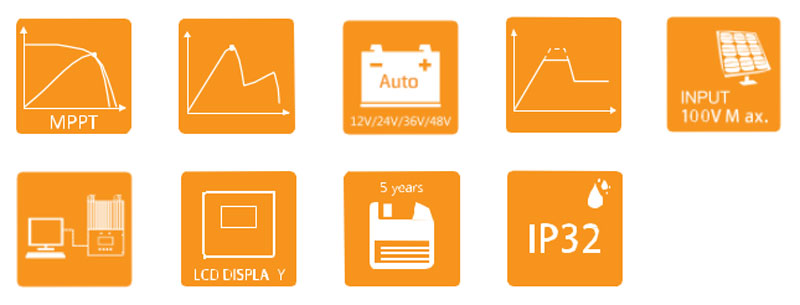
Product Features
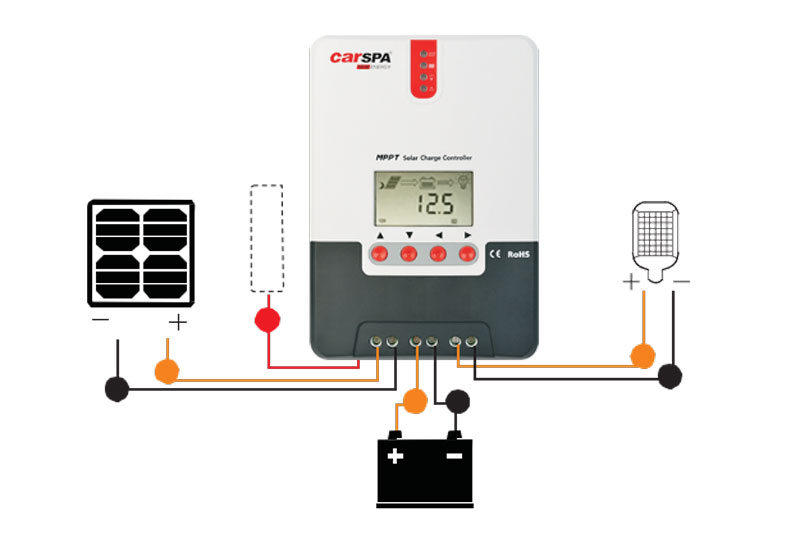
LCD Startup and Main Interface
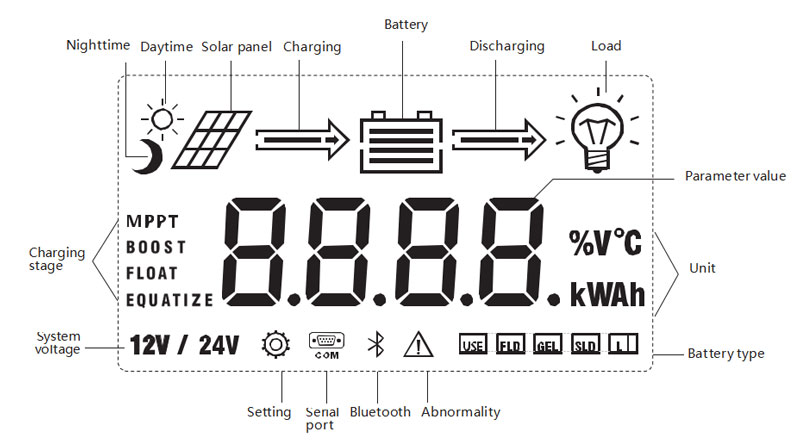
LED Indicators
|
|
|
PV array indicator |
Indicating the controller's current charging mode. |
|
BAT indicator |
Indicating the battery's current state. |
||
|
LOAD indicator |
Indicating the loads' On/ Off and state. |
||
|
ERROR indicator |
Indicating whether the controller is functioning normally. |
PV array indicator:
|
No. |
Graph |
Indicator state |
Charging state |
|
① |
|
Steady on |
MPPT charging |
|
② |
|
Slow flashing (a cycle of 2s with on and off each lasting for 1s) |
Boost charging |
|
③ |
|
Single flashing (a cycle of 2s with on and off lasting respectively for 0.1s and 1.9s) |
Floating charging |
|
④ |
|
Quick flashing (a cycle of 0.2s with on and off each lasting for 0.1s) |
Equalizing charging |
|
⑤ |
|
Double flashing (a cycle of 2s with on for 0.1s, off for 0.1s, on again for 0.1s, and off again for 1.7s) |
Current-limited charging |
|
⑥ |
|
Off |
No charging |
BAT indicator:
|
Indicator state |
Battery state |
|
Steady on |
Normal battery voltage |
|
Slow flashing (a cycle of 2s with on and off each lasting for 1s) |
Battery over-discharged |
|
Quick flashing (a cycle of 0.2s with on and off each lasting for 0.1s) |
Battery over-voltage |
LOAD indicator:
|
Indicator state |
Battery state |
|
Off |
Load turned off |
|
Quick flashing (a cycle of 0.2s with on and off each lasting for 0.1s) |
Load overloaded/ short-circuited |
|
Steady on |
Load functioning normally |
ERROR indicator:
|
Indicator state |
Battery state |
|
Off |
System operating normally |
|
Steady on |
System malfunctioning |
Key Operations
|
▲Up |
Page up; increase the parameter value in setting |
|
▼Down |
Page down; decrease the parameter value in setting |
|
►Return |
Return to previous menu (exit without saving) |
|
◄Set |
Enter into sub-menu; set/ save Turn on/ off loads (in manual mode) |
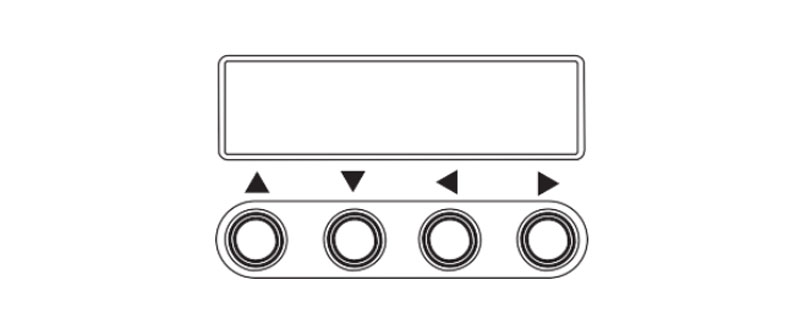
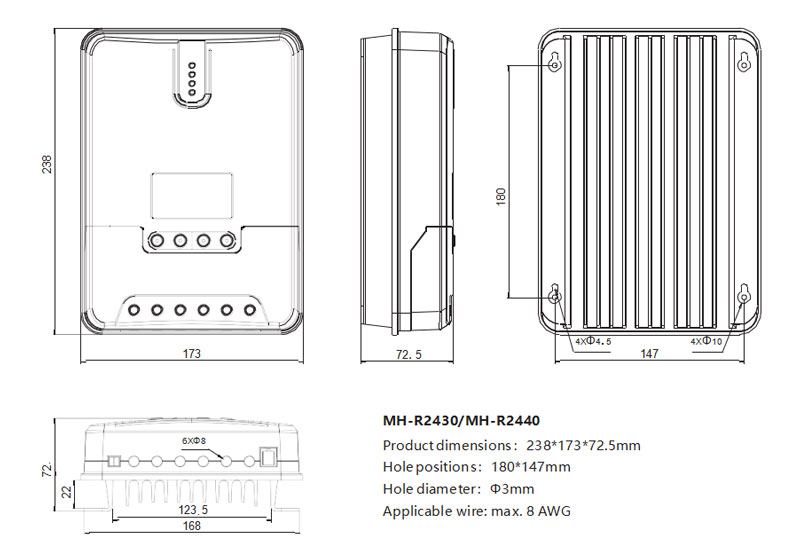
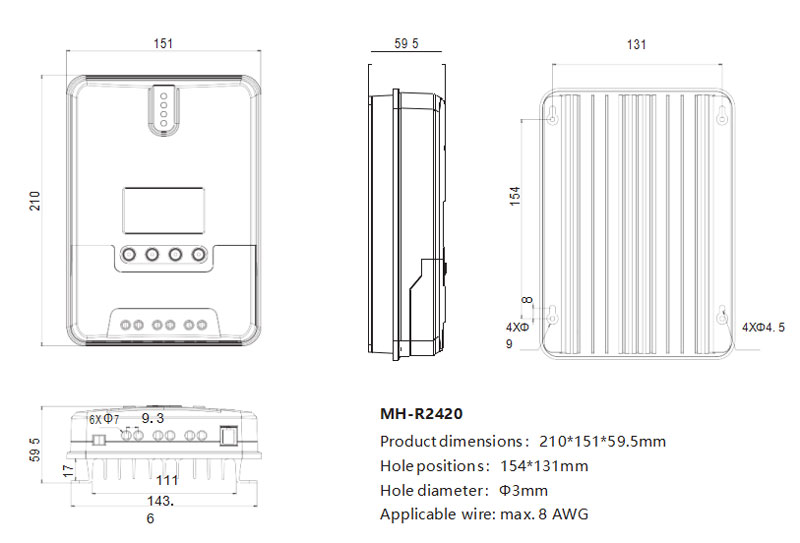
1.Electric Parameters
|
Parameter |
Value |
||
|
Model |
MH-R2420 |
MH-R2430 |
MH-R2440 |
|
System voltage |
12V/24VAuto |
||
|
No-load loss |
0.7 W to 1.2W |
||
|
Battery voltage |
9V to 35V |
||
|
Max. solar input voltage |
100V(25℃)90V(-25℃) |
||
|
Max. power point voltage range |
Battery Voltage+2V to 75V |
||
|
Rated charging current |
20A |
30A |
40A |
|
Rated load current |
20A |
||
|
Max. capacitive load capacity |
10000uF |
||
|
Max. photovoltaic system input power |
260W/12V 520W/24V |
400W/12V 800W/24V |
520W/12V 1040W/24V |
|
Conversion efficiency |
≤98% |
||
|
MPPT tracking efficiency |
>99% |
||
|
Temperature compensation factor |
-3mv/℃/2V(default) |
||
|
Operating temperature |
-35℃ to +45℃ |
||
|
Protection degree |
IP32 |
||
|
Weight |
1.4Kg |
2Kg |
2Kg |
|
Communication method |
RS232 |
||
|
Altitude |
≤ 3000m |
||
|
Product dimensions |
210*151*59.5mm |
238*173*72.5mm |
238*173*72.5mm |
2.Battery Type Default Parameters (parameters set in monitor software)
|
Parameters cross-reference table for different types of batteries |
||||
|
Voltage to set Battery type |
Sealed lead-acid battery |
Gel lead-acid battery |
Open lead-acid battery |
User (self-customized) |
|
Over-voltage cut-off voltage |
16.0V |
16.0V |
16.0V |
9~17V |
|
Equalizing voltage |
14.6V |
—— |
14.8V |
9~17V |
|
Boost voltage |
14.4V |
14.2V |
14.6V |
9~17V |
|
Floating charging voltage |
13.8V |
13.8V |
13.8V |
9~17V |
|
Boost return voltage |
13.2V |
13.2V |
13.2V |
9~17V |
|
Low-voltage cut-off return voltage |
12.6V |
12.6V |
12.6V |
9~17V |
|
Under-voltage warning return voltage |
12.2V |
12.2V |
12.2V |
9~17V |
|
Under-voltage warning voltage |
12.0V |
12.0V |
12.0V |
9~17V |
|
Low-voltage cut-off voltage |
11.1V |
11.1V |
11.1V |
9~17V |
|
Discharging limit voltage |
10.6V |
10.6V |
10.6V |
9~17V |
|
Over-discharge time delay |
5s |
5s |
5s |
1~30s |
|
Equalizing charging duration |
120minutes |
—— |
120minutes |
0~600minutes |
|
Equalizing charging interval |
30days |
0days |
30days |
0~250D (0 means the equalizing charging function is disabled) |
|
Boost charging duration |
120minutes |
120minutes |
120minutes |
10~600minutes |
When selecting User, the battery type is to be self-customized, and in this case, the default system voltage parameters are consistent with those of the sealed lead-acid battery. When modifying battery charging and discharging parameters, the following rule must be followed:
a complete solar energy system should include at least solar panels, solar charge controllers, energy storage batteries, and suitable inverters.
The news about the power station being attacked in the international news is disturbing. I decided to build a home solar power system that can supply electricity for...
I am an insecure person, especially today when the international situation is becoming increasingly unpredictable. I have been thinking about how to make my home mor...
In modern society, electricity is an integral part of our daily lives. From lighting to insulation, from communications to entertainment, almost every household devi...
GET A QUOTE